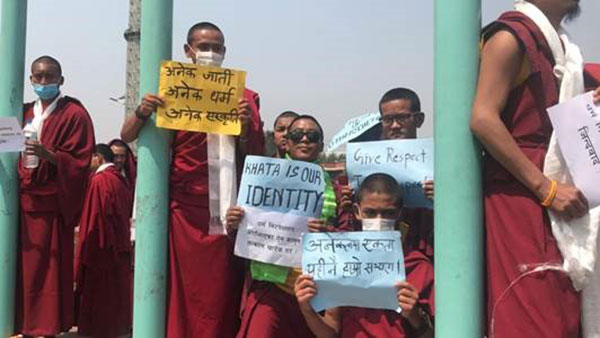The Buddhist community in Nepal has reacted strongly to a politician’s attempt to cast aspersion on their tradition of offering scarves known as khata, a tradition they share with other Himalayan communities such as Ladakhis, Bhutanese, Sikkimese, and Tibetans, among others. A Member of Parliament from Nepal’s Communist Party, Khaga Raj Adhikari, asserted at a public event that the use of the khata in Nepal “hurt the feelings of the Chinese people,” connecting it to Tibet issue and giving political color to a fundamentally spiritual and cultural tradition. The comments made by Adhikari, who is a former Minister, echoes China’s position in Nepal that “pro-Tibet” activities “hurt the feelings of the Chinese people.”
In reaction, the Buddhist community, under the banner of the Nepal Buddhist Federation, held large demonstrations by people from different ethnic groups, including monks and laypeople, to challenge Adhikari and called for the protection of their tradition.
Demonstrations over the weekend (March 30) brought together Sherpas, Tamang, Gurung, Hyolmo, and more wearing khatas.

The demonstration in Nepal. (Photo: Nepal Buddhist Federation)
In remarks about khatas, Adhikari connected them with the Tibet movement, and said that they were not Nepalese. Nepal has a strong Buddhist community: around 10% of the population share a Tibetan Buddhist faith. Khatas have been used historically by citizens of Nepal all along the Himalayan region, whether they were Buddhists or followers of the Bon religion. It has become a common feature at political events, and many Nepalese leaders, including the Prime Minister as well as Maoist leader Prachanda, are regularly seen wearing a khata.
Adhikari is a former Minister of Health and Population. Communities in Nepal, including the Nepalese Buddhist Federation, one of the main organizers of the protests on March 30, are now demanding his resignation. Participants of the demonstration wore khatas and bore signs with messages such as khatas “are our status symbol” and “please respect our tradition.”
Whether or not Adhikari made his statement about the khata under Chinese influence, he has opened himself to the charges through his remarks even as the Nepal government attempts to walk a fine line in its relationship with India and China.
China’s aggressive moves to extend its influence in Nepal have been a cause of concern in the region, and the situation has worsened particularly since Nepal formally joined China’s ‘Belt and Road Initiative.’ The protests demonstrate that many in Nepal are concerned by implications of Nepalese politicians acting in China’s interest.

The demonstration in Nepal. (Photo: Nepal Buddhist Federation)
Nepal is part of China’s strategic imperative to maintain and enforce political ‘stability’ in Tibet, its northern border, meaning that the Chinese authorities seek to ensure complete control and crush of all dissent, underlining a prominent political message that has been emphasized by Xi Jinping: “To rule the country, it is imperative to rule the frontiers; to rule the frontiers, stabilizing Tibet must be done first.” Party officials equate political ‘stability’ in Tibet with the security of the entire PRC, and this approach has been extended to Nepal, with its close historic and cultural ties to Tibet, and location as gateway into exile for Tibetans who seek to leave Tibet – although due to tightening controls particularly from 2008 onward, the border has been largely impenetrable.

